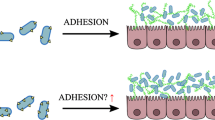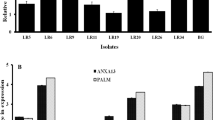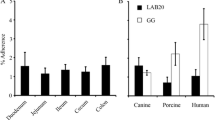Abstract
The probiotic E. coli Nissle 1917 (EcN) has been reported to have various health benefits; however, very little is known about their underlying mechanisms. In this regard, the present study aimed to elucidate the effect of the bacterium on mucin production by intestinal epithelial cells. Incubation of HT-29 cells with EcN lead to a contact time-dependent rise in mRNA levels of the MUC2, MUC3, MUC5AC, and MUC5A. The expression was markedly higher with MUC5AC gene. In most cases, MUC genes expression was more pronounced in polarized cells compared to non-polarized ones. In contrast to MUC3, the basal stimulation of polarized cells brought about markedly higher levels of other tested mucins. Similar but milder results were observed when living EcN was replaced by inactivated bacteria. With exception of MUC3, the conditioned media showed no significant effect on the mRNA level of the tested mucins. The above-mentioned mRNA results were confirmed on protein level using enzyme-linked lectin assay (ELLA) and enzyme-linked immunosorbant assay (ELISA). In contrast to other treatments, basal stimulation of polarized cells showed a growth phase-dependent MUC induction with more prominent effect by stationary-phase bacteria. In contrast to MUC 2 and MUC3, the induction of MUC5AC and MUC5B showed a bacterial count-dependent pattern. In conclusion, EcN was found to stimulate MUC gene expression in HT-29 intestinal cells. This stimulation was more distinct with polarized cells. Such observation may partially interpret some health benefits of the probiotic bacterium including antagonizing pathogen adhesion and protection of the intestinal mucosa.









Similar content being viewed by others
References
Corfield AP, Myerscough N, Longman R, Sylvester P, Arul S, Pignatelli M (2000) Mucins and mucosal protection in the gastrointestinal tract: new prospects for mucins in the pathology of gastrointestinal disease. Gut 47:589–594
Byrd JC, Bresalier RS (2004) Mucins and mucin binding proteins in colorectal cancer. Cancer Metastasis Rev 23:77–99
Hecht G (1999) Innate mechanisms of epithelial host defense: spotlight on intestine. Am J Physiol 277(3 Pt 1):C351–C358
Gork AS, Usui N, Ceriati E, Drongowski RA, Epstein MD, Coran AG, Harmon CM (1999) The effect of mucin on bacterial translocation in I-407 fetal and Caco-2 adult enterocyte cultured cell lines. Pediatr Surg Int 15:155–159
Kruis W, Schutz E, Fric P, Fixa B, Judmaier G, Stolte M (1997) Double-blind comparison of an oral Escherichia coli preparation and mesalazine in maintaining remission of ulcerative colitis. Aliment Pharmacol Ther 11:853–858
Langhendries JP, Detry J, Van Hees J, Lamboray JM, Darimont J, Mozin MJ, Secretin MC, Senetrre J (1995) Effect of a fermented infant formula containing viable bifidobacteria on the fecal flora composition and pH of healthy full-term infants. J Pediatr Gastroenterol Nutr 21:177–181
Buisine MP, Desreumaux P, Leteurtre E, Copin MC, Colombel JF, Porcht NJ, Aubert P (2001) Mucin gene expression in human embryonic and fetal intestine. Gut 49:544–551
Rhodes JM (1997) Colonic mucus and ulcerative colitis. Gut 40:807–808
Forstner JF, Forstner GG (1994) Gastrointestinal mucus. In: Johnson LR (ed) Physiology of the gastrointestinal tract, 3rd edn. Raven, New York, pp 1255–1283
Nutten S, Sansonetti P, Huet G, Bisiaux CB, Meresse B, Colombel JF, Desreumaux P (2002) Epithelial inflammation response induced by Shigella flexneri depends on mucin gene expression. Microbes Infect 4:1121–1124
Garland SM, Tobin JM, Pirotta M, Tabrizi SN, Opie G, Donath S, Tang ML, Morley CJ, Hickey L, Ung L, Jacobs SE (2011) The ProPrems trial: investigating the effects of probiotics on late onset sepsis in very preterm infants. BMC Infect Dis 11:210–219
Baugher JL, Klaenhammer TR (2011) Application of omics tools to understanding probiotic functionality. J Dairy Sci 94:4753–4765
Ouwehand AC, Salminen S, Isolauri E (2002) Probiotics: an overview of beneficial effects. Antonie van Leeuwenhoek 82:279–289
Alander M, Satokari R, Korpela R, Saxelin M, Vilpponen-Salmela T, Mattila-Sandholm T, von Wright A (1999) Persistence of colonization of human colonic mucosa by a probiotic strain Lactobacillus rhamnosus GG, after oral consumption. Appl Environ Microbiol 65:351–354
Schiffrin EJ, Brassart D, Servin AL, Rochat F, Donnet-Hughes A (1997) Immune modulation of blood leukocytes in humans by lactic acid bacteria: criteria for strain selection. Am J Clin Nutr 66:515S–520S
Collado MC, Gueimonde M, Sanz Y, Salminen S (2006) Adhesion properties and competitive pathogen exclusion ability of Bifidobacteria with acquired acid resistance. J Food Prot 69:1675–1679
Mattar AF, Teitelbaum DH, Drongowski RA, Yongyi F, Harmon CM, Coran AG (2002) Probiotics up-regulate MUC-2 mucin gene expression in a Caco-2 cell-culture model. Pediatr Surg Int 18:586–590
Mack DR, Michail S, Wei S, Mc-Dougall L, Hollingsworth MA (1999) Probiotics inhibit enteropathogenic E. coli adherence in vitro by inducing intestinal mucin gene expression. Am J Physiol 276(4 Pt 1):G941–950
Hafez M, Hayes K, Goldrick M, Warhurst G, Grencis R, Roberts IS (2009) The K5 capsule of Escherichia coli strain Nissle 1917 is important in mediating interactions between intestinal epithelial cells and chemokine induction. Infect Immun 77:2995–3003
Kohri K, Ueki IF, Nadel JA (2002) Neutrophil elastase induces mucin production by liganddependent epidermal growth factor receptor activation. Am J Physiol Lung Cell Mol Physiol 283:L531–L540
Zyrek AA, Cichon C, Helms S, Enders C, Sonnenborn U, Schmidt MA (2007) Molecular mechanisms underlying the probiotic effects of Escherichia coli Nissle 1917 involve ZO-2 and PKCz redistribution resulting in tight junction and epithelial barrier repair. Cell Microbiol 9:804–816
Altenhoefer A, Oswald S, Sonnenborn U, Enders C, Schulze J, Hacker J, Oelschlaeger TA (2004) The probiotic Escherichia coli strain Nissle 1917 interferes with invasion of human intestinal epithelial cells by different enteroinvasive bacterial pathogens. FEMS Immunol Med Microbiol 40:223–229
Bengmark S (1998) Immunonutrition: role of biosurfactants, fibre and probiotic bacteria. Nutrition 14:585–594
Vieira MA, Gomes TA, Ferreira AJ, Knöbl T, Servin AL, Liévin-Le Moal V (2010) Two atypical enteropathogenic Escherichia coli strains induce the production of secreted and membrane-bound mucins to benefit their own growth at the apical surface of human mucin-secreting intestinal HT29-MTX cells. Infect Immun 78(3):927–938
Kim H, Seo JH, Kim KH (2003) The effect of p38 mitogen-activated protein kinase on mucin gene expression and apoptosis in Helicobacter pylori-infected gastric epithelial cells. Ann NY Acad Sci 1010:90–94
Caballero-Franco C, Keller K, De Simone C, Chadee K (2007) The VSL#3 probiotic formula induces mucin gene expression and secretion in colonic epithelial cells. Am J Physiol Gastrointest Liver Physiol 292:G315–G322
Anderson RC, Cookson AL, McNabb WC, Kelly WJ, Roy NC (2010) Lactobacillus plantarum DSM 2648 is a potential probiotic that enhances intestinal barrier function. FEMS Microbiol Lett 309:184–192
Yolken RH, Ojeh C, Khatri IA, Sajjan U, Forstner JF (1994) Intestinal mucins inhibit rotavirus replication in an oligosaccharide-dependent manner. J Infect Dis 169:1002–1006
Larson MA, Wei SH, Weber A, Mack DR, McDonal TL (2003) Human serum amyloid A3 peptide enhances intestinal MUC3 expression and inhibits EPEC adherence. Biochem Biophys Res Commun 300(2):531–540
Mack DR, Ahrne S, Hyde L, Wei S, Hollingsworth MA (2003) Extracellular MUC3 mucin secretion follows adherence of Lactobacillus strains to intestinal epithelial cells in vitro. Gut 52(6):827–833
El Homsi M, Ducroc R, Claustre J, Jourdan G, Gertler A, Estienne M, Bado A, Scoazec JY, Plaisancié P (2007) Leptin modulates the expression of secreted and membrane-associated mucins in colonic epithelial cells by targeting PKC, PI3 K, and MAPK pathways. Am J Physiol Gastrointest Liver Physiol 293(1):G365–G373
Krimi RB, Kotelevets L, Dubuquoy L, Plaisancié P, Walker F, Lehy T, Desreumaux P, Van Seuningen I, Chastre E, Forgue Lafitte ME, Marie JC (2008) Resistin-like molecule beta regulates intestinal mucous secretion and curtails TNBS-induced colitis in mice. Inflamm Bowel Dis 14(7):931–941
Garg P, Ravi A, Patel NR, Roman J, Gewirtz AT, Merlin D, Sitaraman SV (2007) Matrix metalloproteinase-9 regulates MUC-2 expression through its effect on goblet cell differentiation. Gastroenterology. 2007 May; 132(5):1877–1889. Epub 2007 Feb 23
Hafez M, Hayes K, Goldrick M, Grencis RK, Roberts IS (2010) The K5 capsule of Escherichia coli strain Nissle 1917 is important in stimulating expression of Toll-like receptor 5, CD14, MyD88, and TRIF together with the induction of interleukin-8 expression via the mitogen-activated protein kinase pathway in epithelial cells. Infect Immun 78(5):2153–2162
Kawai T, Akira S (2011) Toll-like receptors and their crosstalk with other innate receptors in infection and immunity. Immunity 34(5):637–650
Gaudier E, Jarry A, Blottière HM, de Coppet P, Buisine MP, Aubert JP, Laboisse C, Cherbut C, Hoebler C (2004) Butyrate specifically modulates MUC gene expression in intestinal epithelial goblet cells deprived of glucose. Am J Physiol Gastrointest Liver Physiol 6:G1168–G1174
Liévin-Le Moal V, Huet G, Aubert JP, Bara J, Forgue-Lafitte ME, Servin AL, Coconnier MH (2002) Activation of mucin exocytosis and upregulation of MUC genes in polarized human intestinal mucin-secreting cells by the thiol-activated exotoxin listeriolysin O. Cell Microbiol 4(8):515–529
Mack DR, Hollingsworth MA (1994) Alteration in expression of MUC2 and MUC3 mRNA levels in HT29 colonic carcinoma cells. Biochem Biophys Res Commun 199(2):1012–1018
Smirnova MG, Kiselev SL, Birchall JP, Pearson JP (2001) Up-regulation of mucin secretion in HT29-MTX cells by the pro-inflammatory cytokines tumor necrosis factor-alpha and interleukin-6. Eur Cytokine Netw 12(1):119–125
Dohrman S, Miyata M, Gallup M, Li JD, Chapelin C, Coste A, Escudier E, Nadel J, Basbaum C (1998) Mucin gene (MUC2 and MUC5AC) upregulation by gram-positive and gram-negative bacteria. Biochem Biophys Acta 1406:251–259
Lee KD, Guk SM, Chai JY (2010) Toll-like receptor 2 and Muc2 expression on human intestinal epithelial cells by Gymnophalloides seoi adult antigen. J Parasitol 96(1):58–66
Kim Y, Kim SH, Whang KY, Kim YJ, Oh S (2008) Inhibition of Escherichia coli O157:H7 attachment by interactions between lactic acid bacteria and intestinal epithelial cells. J Microbiol Biotechnol 18(7):1278–1285
Radhakrishnan P, Halagowder D, Devaraj SN (2007) Altered expression of MUC2 and MUC5AC in response to Shigella infection, an in vivo study. Biochim Biophys Acta 1770:884–889
Hong DH, Petrovics G, Anderson WB, Forstner J, Forstner G (1999) Induction of mucin gene expression in human colonic cell lines by PMA is dependent on PKC-epsilon. Am J Physiol 277(5 Pt 1):G1041–G1047
Perrais M, Pigny P, Copin MC, Aubert JP, Van Seuningen I (2002) Induction of MUC2 and MUC5AC Mucins by factors of the epidermal growth factor (EGF) family is mediated by EGF receptor/ras/raf/extracellular signal-regulated kinase cascade and Sp1. J Biol Chem 277(35):32258–32267
Author information
Authors and Affiliations
Corresponding author
Rights and permissions
About this article
Cite this article
Hafez, M.M. Upregulation of Intestinal Mucin Expression by the Probiotic Bacterium E. coli Nissle 1917. Probiotics & Antimicro. Prot. 4, 67–77 (2012). https://doi.org/10.1007/s12602-012-9092-0
Published:
Issue Date:
DOI: https://doi.org/10.1007/s12602-012-9092-0




